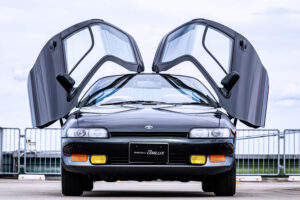Akira Z from “Shakotan★Boogie” fully reproduced
The works-spec Nissan S30 “Fairlady Z” is famous for the “Akira Z” that appeared in the manga “Shakotan★Boogie”, which realistically depicts the car life of young people in their yanky youth. The S30Z introduced here is the ultimate reproduction of Akira’s Z. The stunning style looks as if it has jumped straight out of the world of “Shakotan★Boogie”.
The body is all painted in yellow
The works-spec Nissan S30 “Fairlady Z” is famous as the “Akira Z” that appeared in the manga “Shakotan★Boogie,” which realistically depicts the car life of young people in their youthful days. Car tinkering in the Showa period developed by leaps and bounds, prioritizing coolness over performance. In that sense, the influence of this manga was so great that many old car drivers recreated the modification style of the time and learned a lot from it.
Mr. Shimazaki, who built this Akira Z replica, is also an old car rider who longs for the good old days. Shimazaki’s Nissan S30 Fairlady Z is a late 1972 model, a perfect replica of Akira’s Z, which appeared as a rival to Hajime and Koji in “Shakotan★Boogie. Furthermore, the body is a replica of the yellow color that appeared in the Young Magazine serialization at the beginning of the series color commonly known as the “U-zero” color, and even the all-penned appearance.
In addition, the “Yanky Mate” logo, which became Akira Z’s nickname, is applied to the hood and sides in large cutting sheets to make it easily recognizable and appealing.
A mix of manga and movie-style
The cool and stylish exterior of this street racer is armed with a racing chin spoiler and works over fenders, in addition to a G nose (nickname for the 240ZG’s front bumper). The wheels that fit on them are SSR’s Speedster Mark 1, also known as 1 yen coin wheels, in sizes F: 9J x 15, R: 10J x 15. The tires are a combination of F: 195/50-15, and R: 205/55-15, set with high air pressure for a pulling effect.

Also, there are some differences from the cartoon regarding the rear. The split wing is made to look similar, but the beautiful iron gates are made lighter by eliminating the glass. Another difference from the manga is the large open ducts on the fenders. In the manga, the ducts are double-row, but Shimazaki’s car has triple-row ducts.
This specification is the style used in the live-action movie version of the car, and the maniacal modification style that can be clearly understood by those who know what they are doing is Mr. Shimazaki’s particular style. It is not the same specification, but rather a specification that enjoys a sense of fun by adding elements of the manga version and the movie version in some parts.
translated by DeepL














































